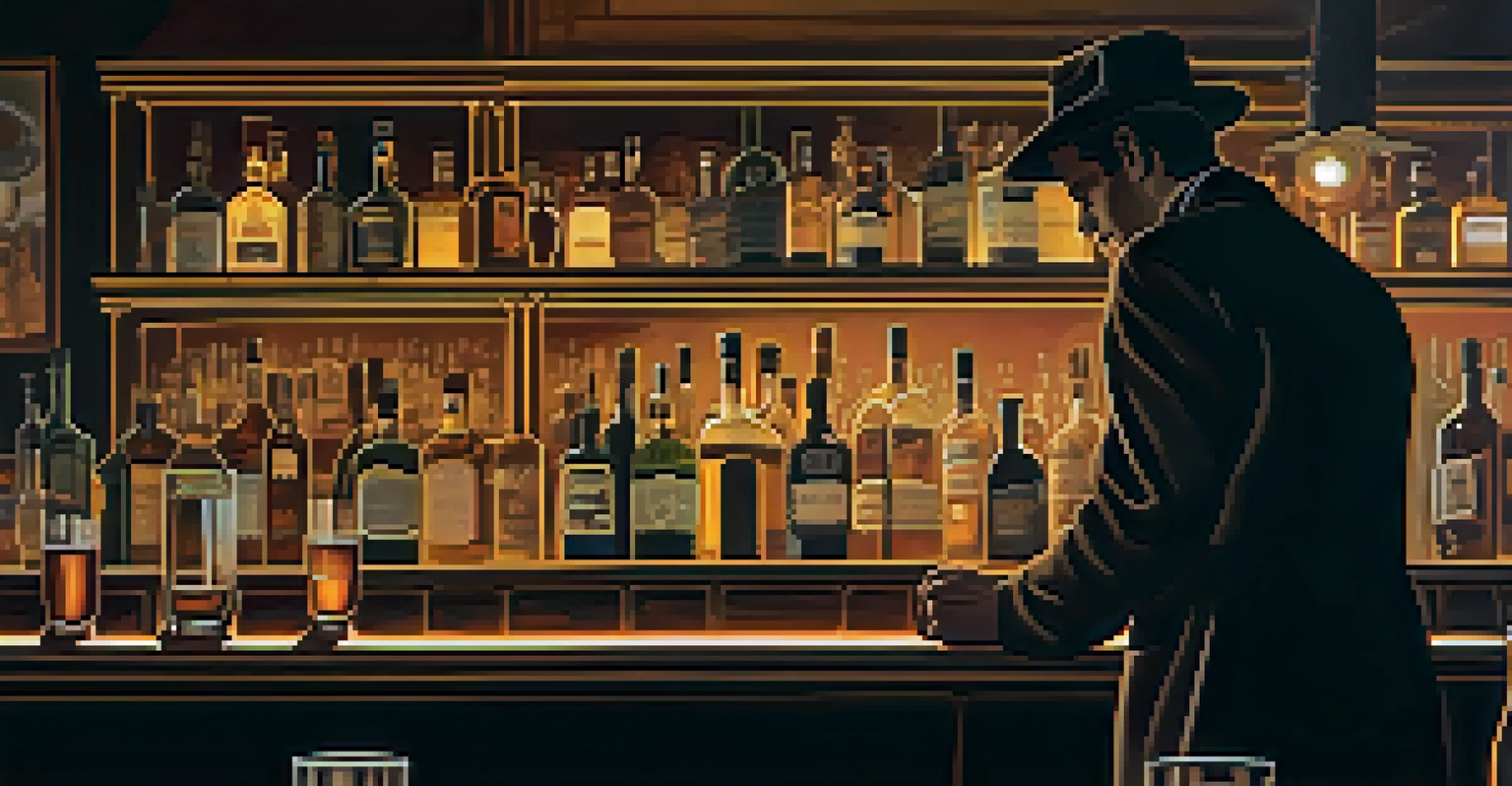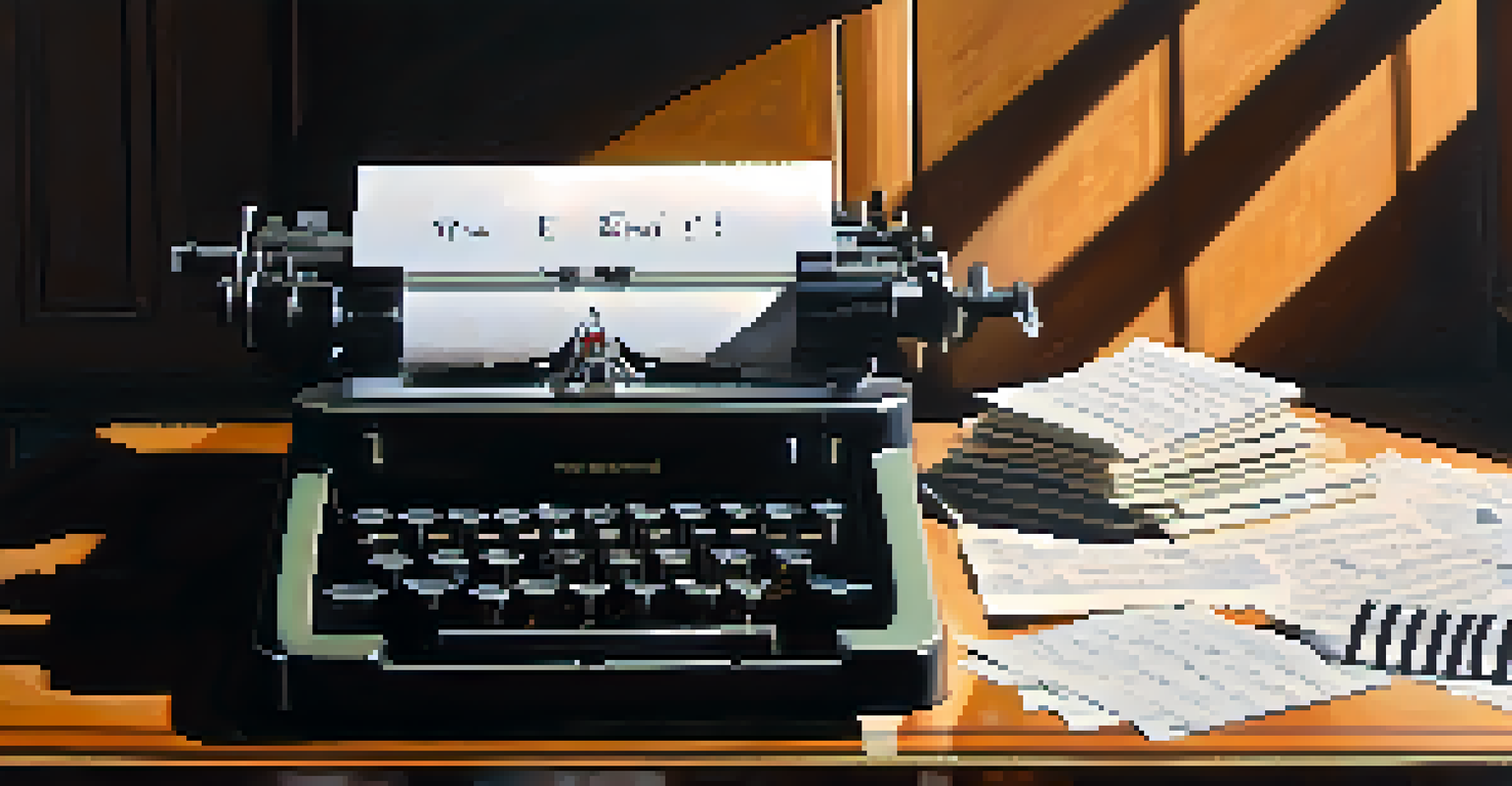How Film Noir Influenced the Evolution of Crime Literature

Defining Film Noir and Its Characteristics
Film noir, a cinematic style that emerged in the early 1940s, is known for its distinctive visual and thematic elements. Characterized by stark lighting, moral ambiguity, and complex characters, it creates a world that feels both alluring and dangerous. The narratives often revolve around crime, betrayal, and a sense of existential dread, which captivates audiences and readers alike.
Film noir is a style of filmmaking that is defined by its use of low-key lighting and its themes of moral ambiguity, existentialism, and the darker side of human nature.
What sets film noir apart is its focus on the darker aspects of human nature. Unlike typical crime stories that often have clear heroes and villains, noir films present characters who are deeply flawed, making morally questionable decisions. This complexity invites viewers to explore the gray areas of morality, a theme that has profoundly influenced crime literature.
Moreover, the aesthetic of film noir—think shadowy alleys and smoky bars—has inspired countless authors to adopt a similar tone in their writing. This visual flair not only enhances the storytelling but also immerses readers into a world filled with suspense and intrigue, echoing the cinematic experience of classic noir films.
The Impact of Noir on Crime Fiction
As film noir gained popularity, it began to permeate crime fiction, creating a new subgenre that mirrored its themes and styles. Authors started to embrace the gritty realism and psychological complexity that noir represented, crafting narratives that were as engaging as the films. This shift brought about a fresh perspective on crime stories, moving away from the traditional whodunit format.

Writers like Raymond Chandler and Dashiell Hammett, who were already paving the way for hard-boiled detective fiction, found themselves influenced by the visual and thematic aspects of film noir. Their characters became more morally ambiguous, often grappling with their inner demons while navigating a corrupt world. This transition not only added depth to character development but also made crime literature more relatable and engaging for readers.
Film Noir's Influence on Crime Fiction
Film noir has significantly shaped crime fiction, introducing themes of moral ambiguity and complex characters that challenge traditional storytelling.
Additionally, the incorporation of noir elements into crime fiction allowed for a broader exploration of societal issues, such as corruption and injustice. This made the narratives not just about solving a crime but also about understanding the human condition, which resonates with audiences on a deeper level.
Notable Authors Influenced by Film Noir
Many contemporary authors owe a debt to the film noir style, with their works reflecting its influence in various ways. For instance, writers like James Ellroy and Patricia Highsmith have crafted stories that delve into the darker sides of human nature, echoing the themes prevalent in classic noir films. Their narratives often blur the lines between right and wrong, mirroring the complexity of film noir characters.
The characters in film noir are often trapped in a moral maze, with no clear way out, reflecting the complexities of real life.
Highsmith’s psychological thrillers, such as 'Strangers on a Train,' showcase a blend of suspense and moral ambiguity, reminiscent of the tension found in noir cinema. Similarly, Ellroy’s gritty Los Angeles stories highlight corruption and crime in a way that feels both cinematic and deeply immersive. These authors have taken the essence of film noir and woven it into the fabric of modern crime literature.
Moreover, the legacy of film noir continues to inspire new generations of writers. They are encouraged to push boundaries, experiment with narrative structure, and explore the psychologically intricate landscapes that noir so effectively portrays.
The Role of Setting in Noir and Crime Literature
Setting plays a crucial role in both film noir and crime literature, often becoming a character in its own right. The dark, rain-soaked streets and dimly lit bars depicted in noir films create a palpable sense of foreboding that seeps into the narratives. This atmospheric backdrop enhances the tension, immersing readers in a world where danger lurks around every corner.
In crime literature, authors have adopted similar settings to evoke mood and tension. The use of urban landscapes, with their hidden corners and shadowy alleys, allows for a rich exploration of crime and morality. This connection between setting and story not only heightens suspense but also serves as a reflection of the characters’ internal struggles.
Setting as a Character in Noir
The atmospheric settings in film noir and crime literature enhance tension and reflect the characters' internal struggles, becoming integral to the narrative.
Additionally, the gritty environments often symbolize the moral decay present in the narratives. Just as film noir uses its setting to mirror the characters' dilemmas, crime literature employs this technique to delve into the themes of corruption and despair, making the stories all the more impactful for readers.
Moral Ambiguity: A Shared Theme
One of the most compelling aspects of both film noir and crime literature is the theme of moral ambiguity. Characters are often faced with choices that challenge traditional notions of right and wrong, forcing readers to grapple with their own moral compasses. This complexity adds depth to the stories, making them more than just a simple tale of good versus evil.
In film noir, protagonists are frequently anti-heroes, navigating a world where the lines between justice and vengeance blur. Similarly, in crime literature, characters often find themselves in situations that test their ethics and values, leading to unpredictable outcomes. This shared theme invites readers to question their own beliefs and consider the consequences of their decisions.
By presenting morally ambiguous situations, both mediums encourage a deeper exploration of human nature. This has allowed crime literature to evolve significantly, pushing boundaries and challenging readers to confront the uncomfortable realities of life.
The Evolution of Narrative Techniques
The storytelling techniques found in film noir have significantly influenced the narrative styles used in crime literature. Non-linear storytelling, unreliable narrators, and fragmented timelines are all techniques that originated in the cinematic style of noir. These elements add layers of complexity to the narrative, making for a more engaging and thought-provoking experience.
Authors began to experiment with these techniques, creating narratives that unfolded in unexpected ways. This shift not only kept readers on their toes but also allowed for a deeper exploration of character motivations and psychological states. The influence of film noir has thus led to a richer tapestry of storytelling in crime literature.
Legacy of Film Noir in Modern Stories
The enduring legacy of film noir continues to inspire contemporary authors, encouraging exploration of dark themes and societal issues in crime narratives.
Additionally, the use of dialogue in both film noir and crime fiction reflects a sharp, witty style that has become a hallmark of the genre. This engaging dialogue not only propels the story forward but also reveals character traits and motivations, enhancing the overall reading experience.
The Lasting Legacy of Film Noir
The influence of film noir on crime literature is undeniable, having reshaped how stories in this genre are told and perceived. Its stylistic and thematic elements have become a foundation upon which countless authors build their narratives. The legacy of film noir continues to resonate today, inspiring a wide range of crime stories across various media.
As the boundaries between film and literature blur, new adaptations and interpretations of noir themes emerge, keeping the genre fresh and relevant. Authors explore contemporary issues through the lens of noir, reflecting society's ongoing struggles with morality, justice, and the human condition. This adaptability ensures that the essence of film noir remains vital in modern crime narratives.

Ultimately, the enduring impact of film noir serves as a reminder of the power of storytelling. It encourages writers to explore the darker aspects of life, challenging readers to confront their own beliefs while navigating the complexities of crime, morality, and human nature.